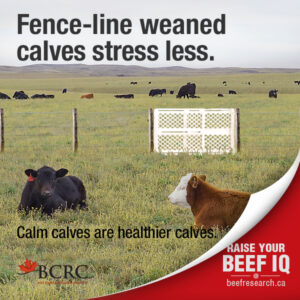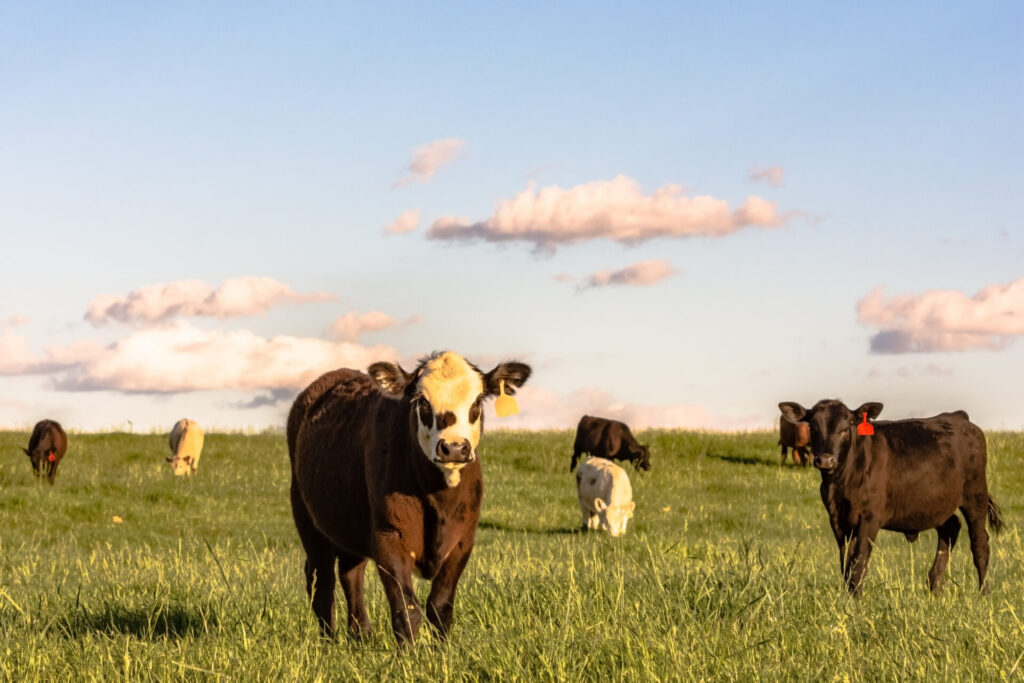
Calves are weaned to make sure that cows can recover their body condition before heading into winter, and to allow for specialized feeding of those calves. The abrupt separation of calves from their dams is the most common approach to weaning, but it’s also the most stressful, and calves that experience a lot of stress under perform.
| Key Points |
|---|
| Calves that are abruptly weaned have higher rates of bovine respiratory disease (BRD) infections and experience lower feed intakes caused by stress, reducing weight gain. |
| Common behavioural indicators of stress in beef calves are increased vocalizations and time spent walking or pacing. |
| Low stress weaning techniques include two-stage weaning and fence-line weaning. |
| Low stress weaning techniques, such as two-stage or fence-line weaning, can reduce the need for treatment, improve feed intake and help build a reputation for easy-doing, healthy, high-performing calves worth a premium. |
| To decrease weaning stress, practice low stress animal handling. |
| Weaning is already stressful, don’t increase stress by also castrating, dehorning, branding and/or vaccinating at weaning time. |
| Make feed and water sources available to calves before they are separated from their dams (creep feed). |
| Gradually transition calves onto new feed and water sources (bunk-break). |
| When possible, move the cows away from the calves instead of moving the calves away from the cows. |
Introduction
The following table outlines the requirements, advantages and disadvantages of each low-stress weaning Weaning is stressful for calves: sudden deprivation of milk and social contact with mothers, handling for vaccinations, changes to feed and water sources and transportation to a different environment with unfamiliar pen mates is a lot for young animals to cope with. The stress calves experience through weaning depresses their immune systems, making freshly weaned calves the most susceptible to bovine respiratory disease (BRD) infections. Stressed calves also have lower feed intakes. Listening to their bawling, seeing them pace in their pens and dealing with sick calves is also stressful for producers.
Understanding the principle of low-stress weaning allows producers to adopt weaning practices that work best on their operation while enjoying the benefits of reduced disease incidence in calves, reduced costs and time spent on treatments, better weight gain and a quieter barnyard.
Low-stress management ideas are not only relevant to those who retain ownership of feeder or replacement heifer calves. For producers that sell direct to backgrounders or feedlots, practicing low-stress techniques can help build a reputation for easy-doing, healthy, high-performing calves that may attract a premium. Minimizing stress during weaning is not only more profitable in the long run for cattle producers, it is also attractive to consumers. Consumers are increasingly concerned about the welfare of livestock and the use of antimicrobials.
Low-stress weaning techniques are key to supporting welfare and disease prevention in freshly weaned calves, thereby reducing the need for antibiotic treatments. The Code of Practice for the Care and Handling of Beef Cattle recommends developing a weaning strategy that minimizes stress, such as two-stage or fence-line weaning1. These practical weaning methods more closely imitate the natural weaning process where a cow rejects a calf’s attempts to nurse.
Quantifying Stress in a Beef Animal
In a research setting, hormones such as cortisol can be measured to estimate stress levels. If a spike in cortisol levels is found, it is generally accepted as an indication that a stressful event has occurred. However, producers do not have the means to measure cortisol levels, so they must rely on indicators of animal behaviour. Increased vocalizations and the amount of time spent eating versus the amount of time spent walking or pacing are common behavioural indicators of stress. While these methods are evaluated subjectively on-farm, scientific measurements of these behaviours can provide insight into the amount of stress an animal may be experiencing.
Weaning Methods
The method of weaning used on each operation will depend on a number of factors, including labour availability, facilities, time of year and weather conditions.
The 2023 Canadian Cow-Calf Survey showed that over 32% of respondents used fence-line weaning, and almost 12% used two-stage weaning. Compared to the survey of the 2014 calf crop, the use of fence-line weaning has increased by over 10% and the number of producers using two-stage weaning has almost doubled. The most common reason given for the high proportion of continued use of traditional separation or abrupt weaning was that calves are marketed at weaning. Other concerns include lack of time, labour or infrastructure and lack of financial incentive for low stress weaning.
Traditional Weaning
Traditional weaning involves the abrupt separation of calves from dams. Calves are removed from the cow and shipped to backgrounding pens on-farm or directly to market or feedlot. Facilities are needed only for the initial separation of cows and calves. In traditional weaning, cows tend to be left in the pasture while the calves are removed to another location.
Two-Stage Weaning

Two-stage weaning uses anti-suckling nose paddles to separate calves from accessing milk before they are separated from their dams.
In Stage 1, calves wear the nose-paddles for 4-5 days. In Stage 2, the nose-paddles are removed and the calves are separated from the dams. Leaving nose paddles in too long may lead to nose sores, so careful timing is required.
This weaning method requires an extra trip through the chute unless the nose-paddle removal is coordinated with another handling event. Research by Dr. Derek Haley, a veterinarian and associate professor at the Ontario Veterinary College in Guelph, found that calves that underwent two-stage weaning with anti-suckling nose-paddles vocalized 97% less, spent 23% more time eating and walked 5.8 kilometers per day less than their abruptly weaned counterparts in the four days after separation from their dams2. In addition, the dams of the two-stage weaning calves vocalized 84% less.
While there are some perceptions that two-stage weaning is more suited to smaller beef herd operations, producers with 300 head to 1,100 head say the extra time and management to attach and retrieve nose paddles is worth the effort. Research supports producer observations of improved health outcomes of calves weaned in two stages compared to abrupt weaning3.
Video: Two-Stage Weaning
Learn more about two-stage weaning, see how to put nose-paddles in calves and hear from producers that have tried this method in this 5-minute video produced by and featuring Dr. Joseph Stookey, a (now retired) researcher of animal behaviour and cattle handling at the University of Saskatchewan.
Fence-Line Weaning
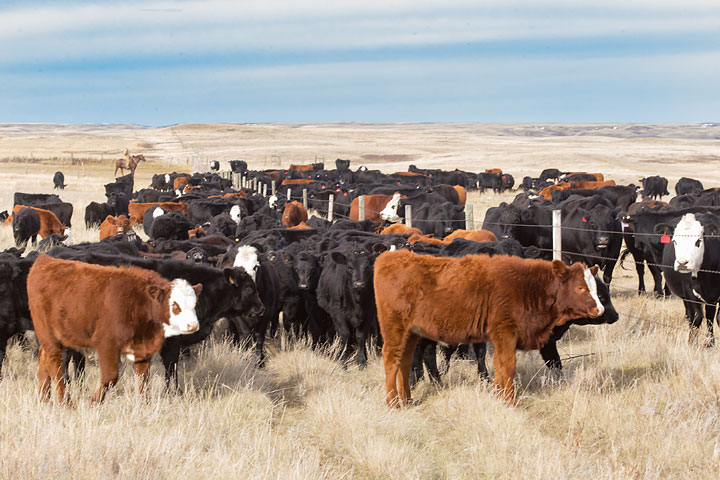
Fence-line weaning separates cows and calves with a fence, but they can still see, hear and smell one another, and preferably also have nose-to-nose contact. Research has demonstrated that fence-line weaned calves have higher overall average daily gain and fewer treatments in the post-weaning period than traditionally weaned calves4,5,6,7. Fence-line weaning programs can be set up based on a producer’s existing facilities. Cows and calves should be kept apart for at least 3-4 days and fencing must be sturdy. Page wire or 6 strands of barbed wire may be necessary to keep calves from getting back with their mothers. Incorporate electric fence if your calves and cows are accustomed to electric fences.
Dr. Henry McCarthy, a practicing veterinarian and cow-calf producer from Wawota, Saskatchewan has been observing the benefits of various low-stress weaning techniques for over 20 years and uses fence-line weaning with his own cattle. His experience is that calves weaned using low-stress practices have a treatment rate of only 5-10%, instead of the 25-30% seen in abruptly weaned calves. Research has shown similar numbers, with fence-line weaned calves treated half as often as abruptly weaned calves4.
There are a number of ways to set up fence-line weaning, such as:
- Separate the cows into a neighboring lot/paddock
- Confine the cows to the corral and leave the calves loose in the neighboring pasture environment that they are already familiar with
- Set up page or electric wire in the pasture and sort cows from calves onto either side
Additional Low-Stress Weaning Techniques
Quiet cattle handling
Regardless of weaning method, practicing quiet handling methods is key. When handlers are quiet and move carefully in well-designed facilities, cattle remain calm. A stressful handling experience while weaning calves can undo the benefits you would have seen otherwise seen by using low-stress techniques. Using low stress handling techniques for separations of cow-calf pairs, moving cattle and loading trailers can help improve outcomes.
Video: Efficient and Novel Method for Sorting Cow-Calf Pairs
This 1.5-minute video shows an easy, low-stress method of separating cow-calf pairs. It was produced by Dr. Joseph Stookey.
Video: Beef Cattle Behaviour and Handling
For good tips on how to modify existing handling facilities to reduce stress on cattle, watch this video featuring Dr. Temple Grandin, designer of livestock handling facilities and a Professor of Animal Science at Colorado State University.
Gradually transition calves onto new feed
Make feed and water sources available to calves before they are separated from their dams. That way calves will already have learned where to find feed and water once their dams are removed.
Perform other stressful events at another time
The number of stressors animals experience at a time should be limited as much as possible. Castration, dehorning, branding and initial vaccinations should all be done well in advance of weaning. Strategies such as low stress separation of cow-calf pairs may help with logistical challenges of gathering and handling cattle prior to weaning.
When possible, move the cows instead of the calves
Being transported or moved to a new environment is stressful on calves so when possible, allow the calves to stay in their familiar environment and move the dams. Older cattle are better able to cope and have fewer sources of stress during weaning compared to the calves.
Which Weaning Method is Best for My Operation?
The following graphics outline the requirements, advantages and disadvantages of each low-stress weaning method.
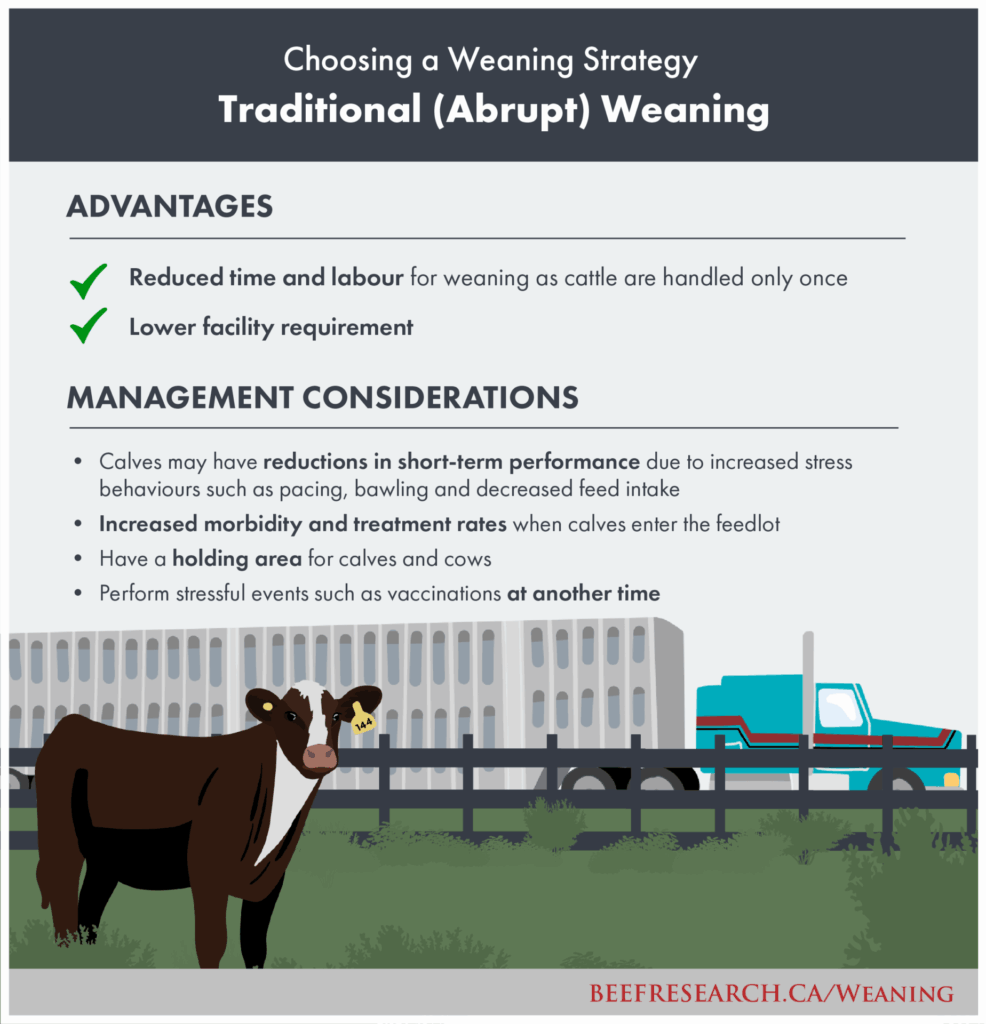
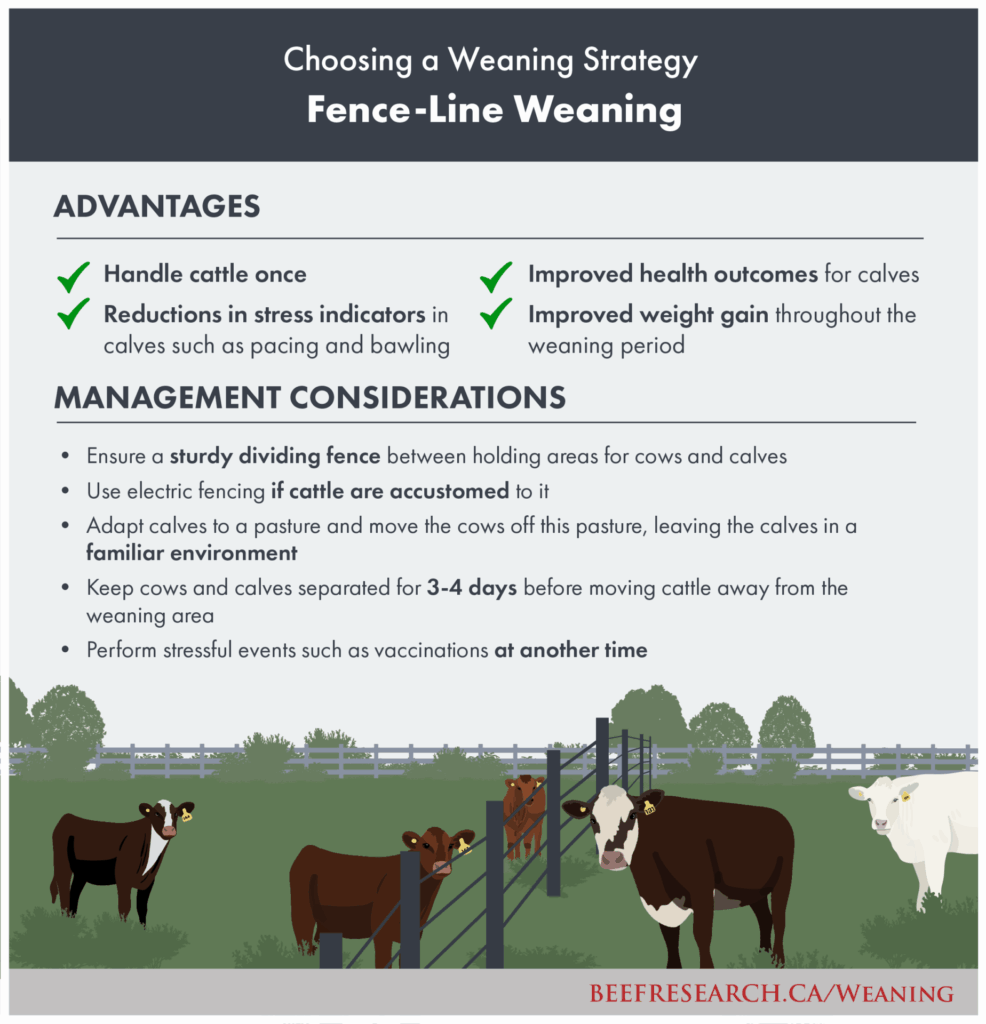
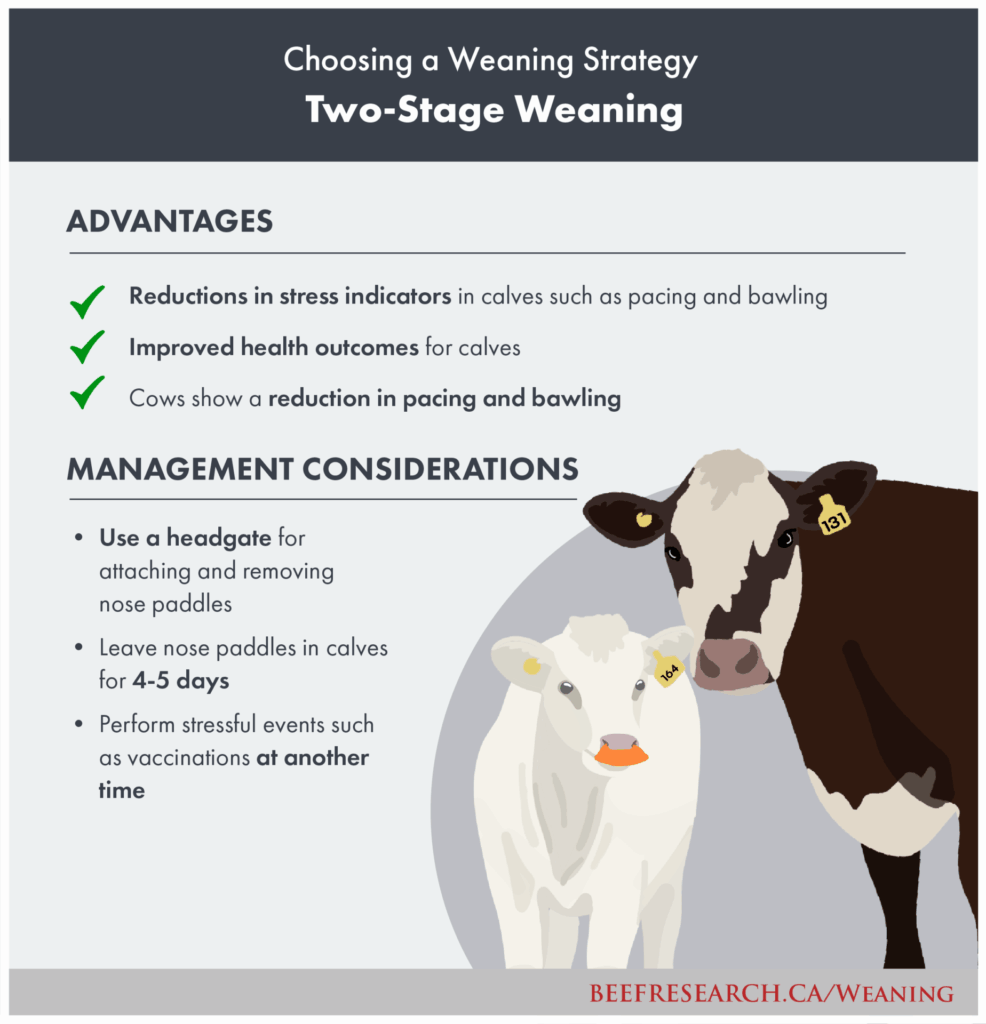
Early Weaning
Weaning around 210 days of age helps manage cow reproductive cycles. The 2023 Canadian Cow-Calf Survey showed that the average weaned age of calves is 215 days for calves born to cows and 212 days for calves born to heifers. However, in years where drought limits forage supply and quality, early weaning may be considered along with other management strategies to reduce the nutritional burden on the cow and stretch pasture resources. Early weaning occurs when calves are 1-5 months of age.
Considerations of early weaning include impact on the cows, the calves and pastures.
For the cow: Early weaning can help set your cows up for the next breeding season. Reduced nutritional burden through lactation will make it easier to improve cow Body Condition Score, which will impact winter feeding, calving and rebreeding the following year.
For the calf: Early weaned calves efficiently convert feed to gain. However, these calves need careful management in the post-weaning period, including tightly controlled nutrition, clean water and dust-free environments.
Vaccinate and castrate calves prior to weaning. Ensure the calf ration post-weaning includes trace mineral and vitamin supplementation. Avoid silage as the transition diet due to taste and smell factors that may reduce calf feed intake.
Early weaned calves may be more susceptible to stress and health issues. Talk to your veterinarian about a health plan suitable for young calves.
For the pasture: Early weaning removes calves from pasture and reduces the amount and quality of feed a cow requires. Therefore, early weaning can increase the number of days on pasture and decrease the number of days on stored feed.
Facilities and labour: Early weaning may require different facilities and have higher labour requirements. If calves are kept on-farm, feed bunks and water troughs must be low enough for calves to access. Feeding these young calves will also take time.
- References
-
1. Canadian Cattle Association and National Farm Animal Care Council. (2013). Code of Practice for the Care and Handling of Beef Cattle. Available here.
2. Haley, D. B., Bailey, D. W., & Stookey, J. M. (2005). The effects of weaning beef calves in two stages on their behavior and growth rate. Journal of animal science, 83(9), 2205-2214.Available here.
3. Lippolis, K. D., Ahola, J. K., Mayo, C. E., Fischer, M. C., & Callan, R. J. (2016). Effects of two-stage weaning with nose flap devices applied to calves on cow body condition, calf performance, and calf humoral immune response. Journal of Animal Science, 94(2), 816-823. Available here.
4. Boyles, S. L., Loerch, S. C., & Lowe, G. D. (2007). Effects of weaning management strategies on performance and health of calves during feedlot receiving. The Professional Animal Scientist, 23(6), 637-641. Available here.
5. Taylor, J. D., Gilliam, J. N., Mourer, G., & Stansberry, C. (2020). Comparison of effects of four weaning methods on health and performance of beef calves. Animal, 14(1), 161-170. Available here.
6. Gubbels, E. R., Salverson, R. R., Cammack, K. M., Grubbs, J. K., Underwood, K. R., Olson, K. C., & Blair, A. D. (2020). Effects of Low-Stress Weaning on Calf Growth Performance and Carcass Characteristics. South Dakota State University Beef Day 2020: Meats & Human Nutrition, 117-124. Available here.
7. Bailey, E. A., Jaeger, J. R., Waggoner, J. W., Preedy, G. W., Pacheco, L. A., & Olson, K. C. (2016). Effect of fence-line or drylot weaning on the health and performance of beef calves during weaning, receiving, and finishing. The Professional Animal Scientist, 32(2), 220-228. Available here.
Feedback
Feedback and questions on the content of this page are welcome. Please e-mail us at [email protected]
Acknowledgements
Thanks to Karin Schmid, Beef Production Specialist at Alberta Beef Producers for contributing her time and expertise during the development of this page.
Ce contenu a été révisé pour la dernière fois en Août 2025.
